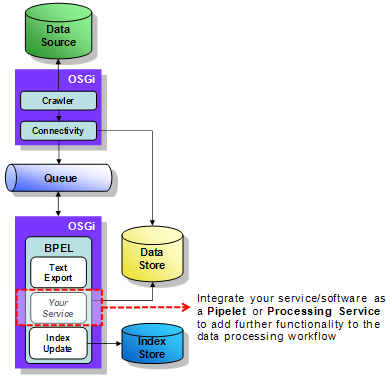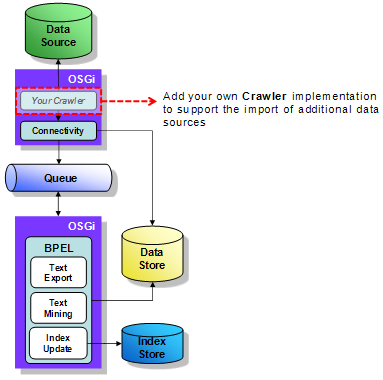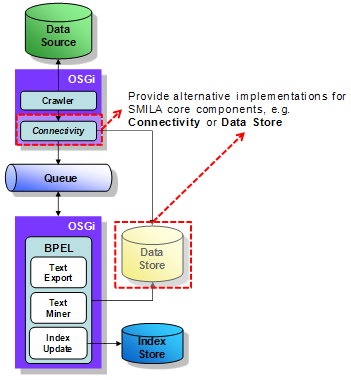Notice: this Wiki will be going read only early in 2024 and edits will no longer be possible. Please see: https://gitlab.eclipse.org/eclipsefdn/helpdesk/-/wikis/Wiki-shutdown-plan for the plan.
SMILA/Documentation/HowTo/Howto integrate a component in SMILA
This page summarizes the different types and complexity levels for the integration of components in SMILA.
Contents
Introduction
Due to its architecture SMILA allows for the easy integration of third-party components into its framework. Actually there are three different possible integration scenarios available that are depicted in the following table.
| Integrating services in BPEL | Integrating agents and crawlers | Integrating alternative implementations for SMILA core components |
|---|---|---|
| This is probably the most frequently used integration scenario. It allows for the integration or exchange of functionality (services, 3rd party software, etc.) used to process records in the workflow engine. | Integrating your own crawler or agent implementations is another common scenario for adding functionality to SMILA. By doing so, further data sources can be unlocked to provide additional input to SMILA. | This scenario is particularly intended for the experienced (SMILA) developer and comprises the possibility to exchange existing implementations of the SMILA core components by your own implementations. |

|

|

|
| The figure demonstrates how you can integrate the functionality of your service or your piece of software to SMILA by adding it to the workflow engine. | The figure above exemplary shows how you can add your own crawler implementation to SMILA. Please note that though you may also add an agent implementation likewise this option is not shown in the figure. This was chosen due to simplicity. | The figure above demonstrates how two of the SMILA core components -- connectivity and data store -- may be exchanged by your own implementations. These components serve as examples only, that is, you may also exchange other core components such as the blackboard service or the delta indexing manager. |
| The above figures exemplary demonstrate at which levels in the SMILA architecture an integration of new components is applicable. However, for simplicity reason, we restricted the above figures to the index processing chain while completely ignoring the search processing chain that also offers similar integration options but is currently not in the focus of this page. | ||
Integrating services in BPEL
As already shown in the overview above, SMILA offers the possibility to integrate your own service or piece of software into SMILA BPEL workflows. In SMILA we simply call these workflows pipelines. A pipeline is the definition of a BPEL process (or workflow) that orchestrates pipelets, processing services, and other BPEL services (e.g. web services).
There are several options on how to achieve this:
- Simple: The easiest method to add functionality is to invoke a web service by using the standard functionality of BPEL. However, the disadvantage is that not all data of SMILA records are accessible if you opt for this method of integration.
- Default: The recommended way to integrate additional functionality in SMILA is to provide Java implementations of two interfaces that allow for an easy creation of the above mentioned pipelets and processing services.
- Advanced: This method extends the default mechanism by providing an alternative procedure for integrating processing services that do not run in the same OSGi runtime as the BPEL workflow but in another OSGI runtime that may even run on a remote machine.
Simple: Integrating web services
The simplest way of integrating additional functionality in SMILA is to call a web service, which is a standard BPEL workflow engine functionality independent of SMILA. However, there are some limitations concerning the input and result data to/from web services: The workflow object (a DOM object) that enters the BPEL workflow in SMILA contains only the record IDs by default. That means records and the data contained therein - attributes, annotations, and attachments - are not accessible from a BPEL workflow because it can only access and use the values contained in the BPEL workflow object.
To overcome this restriction you can add additional data to the workflow object by adding filters in the configuration file located at org.eclipse.smila.blackboard/RecordFilters.xml. These filter rules define which attributes and annotations should be copied to the workflow object to make them accessible in the BPEL workflow. Additionally, you should not forget to include all attributes and annotations in the RecordFilters.xml file that you wish to write data to. Though filters work on attributes and annotations there is no possibility to access attachments of records because binary data is not reasonable in DOM.
Examples
A good example for this use case is the integration of the Language Weaver web service. The Language Weaver Translation Server provides a web service interface that allows a text to be translated into another language. This service could easily be used within SMILA to extend its functionality.
Further reading
Please consult the following how-to tutorials for a more detailed technical description:
Default: Integrating local SMILA pipelets or processing services
The default and thus recommended technique to integrate functionality or software in SMILA is to provide a pipelet or a processing service that runs in the same OSGi runtime as the BPEL workflow engine. Pipelets are easier to implement as they require only standard Java knowledge but lack the functionality of processing services to be shared between multiple pipelines and to be accessed by multiple threads. Another difference is that the lifecycle and configuration of pipelets is managed by the workflow engine whereas processing services are handled by OSGi runtime. For further information on pipelets and processing services refer to Pipelets and ProcessingServices.
The above mentioned restriction of integrated web services using the BPEL default engine functionality does not apply to pipelets and processing services. Both have full access to SMILA records by using the blackboard service, which makes it easy to read, modify, and store records.
In general pipelets and processing services follow the same (sometimes optional) logical steps (of course this depends highly on the business logic to be executed). These steps are:
- Read the configuration (optional)
- Read input data from blackboard (optional)
- Execute the business logic
- Write result data to blackboard (optional)
In terms of the pipelet or processing service that implements the business logic you are totally free to use any desired technology. Some of the posibilities include:
- Using POJOs (For examples refer to the XML processing pipelets)
- Using any local available OSGi service, even other processing services (For an example refer to the Aperture pipelet that uses the ApertureMimeTypeIdentifier processing service.)
- Using other technologies such as JNI, RMI, or CORBA to integrate remote or non Java components (As an example consider the integration of Oracle Outside In Technology.)
Examples
- Typical examples for pipelets are the XML processing pipelets. These lightweight pipelets are used for XML processing (e.g. XSL transformation). Each pipeline uses its own pipelet instance.
- A good example for a processing service is the Lucene index service. It provides functionality to index records in Lucene indexes and can be used from multiple pipelines in parallel.
Further reading
Please consult the following how-to tutorials for a more detailed technical description:
- How to write a pipelet
- How to write a processing service
- How to integrate the HelloWorld web service as a pipelet
Advanced: Integrating remote SMILA processing services
tbd.
Integrating agents and crawlers
Due to the architecture of the SMILA connectivity framework it is easy to include additional data sources by providing appropriate implementations of agents and/or crawlers.
Examples
tbd.
Further reading
Please consult the following how-to tutorials for a more detailed technical description:
Integrating alternative implementations for SMILA core components
The component-based architecture of SMILA even allows you to provide your own implementations of SMILA core components. More info coming soon...
Examples
A typical example is an alternative implementation of the DeltaIndexingManager that does not store its state in memory but in the file system or in a database.
Further reading
tbd.
